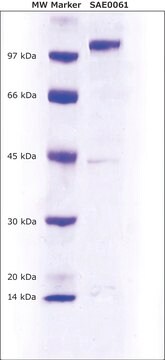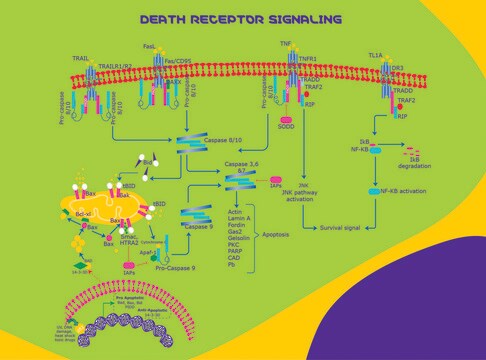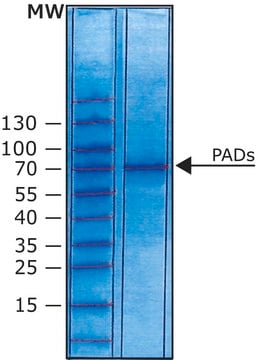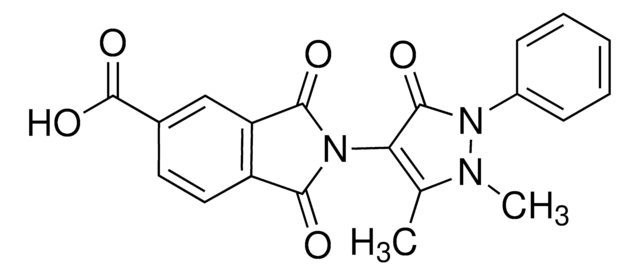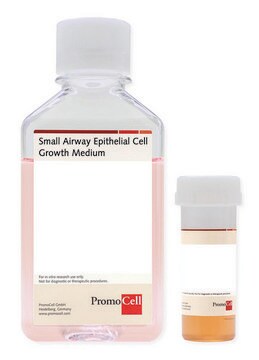SRP5223
PAD1, GST tagged human
recombinant, expressed in baculovirus infected Sf9 cells, ≥70% (SDS-PAGE), buffered aqueous glycerol solution
Sinonimo/i:
HPAD10, PADI1, PDI, PDI1
Autenticatiper visualizzare i prezzi riservati alla tua organizzazione & contrattuali
About This Item
Codice UNSPSC:
12352200
NACRES:
NA.32
Prodotti consigliati
Origine biologica
human
Ricombinante
expressed in baculovirus infected Sf9 cells
Saggio
≥70% (SDS-PAGE)
Stato
buffered aqueous glycerol solution
PM
~95 kDa
N° accesso NCBI
applicazioni
cell analysis
Condizioni di spedizione
dry ice
Temperatura di conservazione
−70°C
Informazioni sul gene
human ... PADI1(29943)
Descrizione generale
Peptidyl arginine deiminase 1 (PAD1) is a member of the peptidyl arginine deiminase family of enzymes. It is a component of the 26S proteasome, a multiprotein complex that degrades proteins targeted for destruction by the ubiquitin pathway. PAD1 is expressed in the epidermis and uterus. The gene encoding this protein is localized on human chromosome 1p36.13.
Azioni biochim/fisiol
Peptidyl arginine deiminases catalyze the post-translational deimination of proteins by converting arginine residues into citrullines in the presence of calcium ions. The overexpression of PAD1 induced a distinctive pattern of multidrug resistance in mammalian cells and moderate resistance to ultraviolet light. PAD1 is also responsible for substrate deubiquitination during proteasomal degradation. It deiminates filaggrin in the last stages of keratinocyte differentiation. Thus, PAD1 has a role in epidermis function and homeostasis. The protein has been genetically associated with rheumatoid arthritis.
Stato fisico
Supplied in 50mM Tris-HCl, pH 7.5, 150mM NaCl, 10mM glutathione, 0.1mM EDTA, 0.25mM DTT, 0.1mM PMSF, 25% glycerol.
Nota sulla preparazione
after opening, aliquot into smaller quantities and store at -70 °C. Avoid repeating handling and multiple freeze/thaw cycles
Risultati analitici
This protein is not assayed for enzymatic activity.
Codice della classe di stoccaggio
10 - Combustible liquids
Classe di pericolosità dell'acqua (WGK)
WGK 1
Punto d’infiammabilità (°F)
Not applicable
Punto d’infiammabilità (°C)
Not applicable
Scegli una delle versioni più recenti:
Certificati d'analisi (COA)
Lot/Batch Number
Non trovi la versione di tuo interesse?
Se hai bisogno di una versione specifica, puoi cercare il certificato tramite il numero di lotto.
Possiedi già questo prodotto?
I documenti relativi ai prodotti acquistati recentemente sono disponibili nell’Archivio dei documenti.
Citrullination of CXCL8 by peptidylarginine deiminase alters receptor usage, prevents proteolysis, and dampens tissue inflammation.
Proost P
The Journal of Experimental Medicine (2008)
Potential Role of Peptidylarginine Deiminase Enzymes and Protein Citrullination in Cancer Pathogenesis
Sunish Mohanan, et.la
Biochemistry Research International (2012)
The peptidylarginine deiminases expressed in human epidermis differ in their substrate specificities and subcellular locations.
Mechin MC
Cellular and Molecular Life Sciences (2005)
Identification of 45 novel SNPs in the 83-kb region containing peptidylarginine deiminase types 1 and 3 loci on chromosomal band 1p36.13.
Lida A and Nakamura Y
Journal of Human Genetics (2004)
Tingting Yao et al.
Nature, 419(6905), 403-407 (2002-09-28)
The 26S proteasome is responsible for most intracellular proteolysis in eukaryotes. Efficient substrate recognition relies on conjugation of substrates with multiple ubiquitin molecules and recognition of the polyubiquitin moiety by the 19S regulatory complex--a multisubunit assembly that is bound to
Il team dei nostri ricercatori vanta grande esperienza in tutte le aree della ricerca quali Life Science, scienza dei materiali, sintesi chimica, cromatografia, discipline analitiche, ecc..
Contatta l'Assistenza Tecnica.
